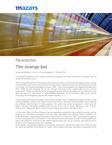
The orange bet
The October elections, when mayors, governors, deputies, and councilmen will be elected, will not be like the previous ones.
They will be different from the previous ones because there is a territorial development tool that did not exist before and that has the power to change urban ecosystems and rescue the depressed areas of the cities, the Orange Development Areas - ADN-. They were created by the National Development Plan -PND- to give physical life to the Orange Economy policy implemented by the current government. These are defined as the "geographic spaces that are delimited and recognized through land use planning instruments or administrative decisions of the territorial entity, which aim to encourage and strengthen cultural and creative activities (...)".
The purpose of this tool is to create cultural and innovation hubs in depressed neighborhoods of cities and municipalities, which in turn attract investment, tourism, development and welfare, thus achieving the effective transformation of these spaces. This policy has proven successful in cities such as Miami, with the Wynwood neighborhood; Buenos Aires, with La Boca; Barcelona, with El Born; Madrid, with “Malasaña”; Berlin, with Prenzlauer Berg; and Lisbon, with Barrio Alto.
To stimulate DNAs, the Plan indicates that municipalities and districts may grant tax benefits such as property tax reductions, exemption from the urban delineation tax, among others. Likewise, the territorial entities, being empowered to do so by Article 38 of Law 14 of 1983, could grant exemptions in their municipal taxes (for example, in the industry and commerce tax) for a term not exceeding ten years and subject to compliance with certain requirements such as, for example, the employment of workers in the neighborhood to be revitalized.
Undoubtedly, the greatest attraction of this policy is that the investments made in the ADN will have the same tax benefits of the Works for Taxes, which implies that large Colombian companies will be able to pay part of their income tax through the investment they make in cultural and innovation infrastructure in such Orange Development Areas.
In this sense, iconic companies from the different regions will be able to serve as the true benefactors and patrons of the arts, culture, and innovation without making additional efforts to those they currently make, since part of their income tax would be destined to investments in such areas.
The bet is brilliant and could transform the fate of depressed neighborhoods in Colombian cities into vibrant cultural and creative districts, where the best of Colombian talent can be developed and exported. The aspirants to be elected to high positions of regional representation should integrate this strategy into their government plans, as this tool will generate a healthy competition to attract investment in the different cultural districts to be created.


